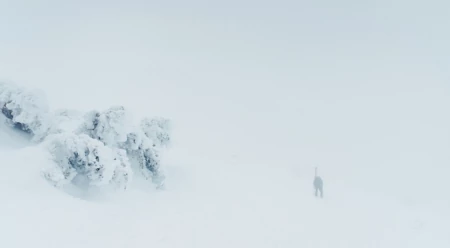The Summit Which Never Melts: Dookʼoʼoosłííd
Snow and icy rime break from the porous black volcanic ridgeline crackling beneath my feet. Gale-force updrafts from the gullied ridges below whip the skis and splitboards strapped to our backs. Each gust forces us to step toward the cornice that hangs above the caldera to our right. The temperature drops steadily and our breath feels increasingly labored as we ascend the ridge. I can just make out the dark, distant silhouette of Forrest struggling through the blowing snow and clouds curving over the ridgeline. I pause to pull off my gloves and examine my fingers to make sure the numbness isn’t frostbite. Scanning the pine forest below, I find it hard to believe that we are in Arizona—this feels like some other place entirely. For these few moments, we are with the mountain in its full power, far above the conflict on the slopes below.
Dookʼoʼoosłííd, also known as Humphreys Peak, in the San Francisco Peaks, rises from the high desert of the American Southwest to a summit of 12,633 feet, just north of the city of Flagstaff, Arizona. This volcanic range, and Dookʼoʼoosłííd in particular, represents a nexus of the impacts of climate change, increasing pressures on water in the West, the outdoor recreation industry, indigenous people, conflicting management priorities and cultural rights. The mountains have been the focal point of intense conflicts between Native American tribes and the Arizona Snowbowl ski resort for decades. The management of them, specifically around the ski area we are now trudging up and through, have magnified cultural differences—between the city of Flagstaff, thirteen American Indian tribes and the snow sports industry—in terms of relationships to landscapes, and how they should be treated.
A few years ago, I would have scoffed at the idea of a Navajo person using snow sports to tell a story about a sacred mountain. For the better part of my teens and twenties I refused to learn how to ski, even when presented with the opportunity, in large part because of the controversy around this mountain. Growing up, I remember hearing in my community about how sewage was going to be used to make snow at a ski resort on one of our sacred mountains near Flagstaff, Arizona. I thought that snow sports and the outdoor industry conflicted with my values as a Navajo person. I watched Native protesters chain themselves to bulldozers on the opening day of the resort, and I remember the heavy-handed deployment of police to arrest organizers. Participating in a sport that, in my view at that time, was desecrating a sacred space conflicted with the teachings I had been raised with as a Navajo person—an ethic of protecting these places for those coming after me.
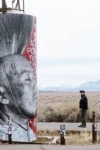
The Navajo Nation border lies less than 15 miles north from the Dook’o’oosłííd massif. Our visit to this mountain included giving cultural context and history to where this mountain lies. Here Len inspects a mural bringing attention to uranium mining on the Navajo Nation at an abandoned gas station south of Cameron, Arizona. Mural artist: Jerrel Singer. Photo: Greg Balkin
It was not until I experienced firsthand the solitude and silence brought by the snow in the mountains that I was drawn to these alpine landscapes. I vividly remember an occasion when I stood still on a snow-packed ridgeline, and began to understand why my tribe, like many others, hold mountains like these to be sacred spaces. I learned to ski much later in life, after I had melded my upbringing and values with the sport to create my own relationship to the mountains. I traded snowshoes for skis because they were the most efficient mode of movement. I found myself at ski resorts, not as an endpoint for my pursuit, but simply as a stepping stone for the places that I wished to go. In the alpine I began to gain a deeper appreciation for the phrase I was taught as a young Navajo, “Tó ei Iina”—water is life. At some point my understanding of the sacred became visceral, as if the movement through these places became my prayers. I have learned the power of this form of water, the respect that it requires, and the fragility of the climate that supports it.
Forrest Shearer has spent much of his life in alpine environments and has seen the impacts of climate change firsthand. Forrest and I have developed a friendship through our advocacy work around climate change and public lands. A few months before climbing Dookʼoʼoosłííd, we chatted about wanting to experience the mountain and work through the cultural viewpoints that are at the root of the conflict over it. Our time together was also an opportunity to bridge the gaps among those viewpoints through sharing perspectives from the communities we each represent.
In the Southwestern United States, the effects of climate change are already being felt. Increasing temperatures are causing snowpack to become more variable and gradually decline. Within the next century it is likely that Dookʼoʼoosłííd will no longer consistently hold a snowpack through the winter. Snow will be replaced by rain, leading to what climate scientists describe as snow droughts. For the city of Flagstaff, the impacts will be significant: each year over 400 million gallons of water is piped from the inner basin of the mountains for municipal uses. The impacts of the loss of snow on the mountain for skiing are obvious. Arizona Snowbowl, one of the southernmost ski resorts in the United States, has relied on artificial snow since the early 2000s to extend seasons and profitability. In the winter of 2013 to 2014, it became the world’s first ski area to make snow almost entirely of municipal sewage effluent. The use of artificial snow and the pressures to reuse water in this increasingly arid environment are all expected responses to the impacts of climate change. Yet the reuse of water in this context has highlighted cultural differences in environmental management and risk perception.
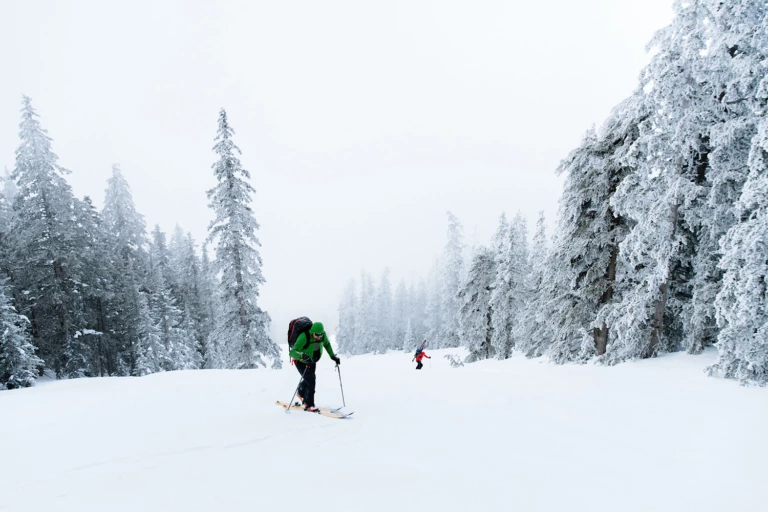
Len Necefer and Aaron Mike skin and bootpack through the Kachina Peaks Wilderness to gain the summit ridge. An overnight storm dropped new snow and coated the forest. Photo: Greg Balkin
For indigenous communities the impacts on ecosystems that rely on the mountain snowpack are more uncertain. The loss of snow will inevitably mean impacts on ceremonial cycles, languages and sacred history that these tribes steward. The medicinal plants and natural springs on the mountain serve an important role in religious ceremonies, however, decreasing snowpacks and rising temperatures threaten their availability. The traditional names of these mountains already serve as a reminder of how much they have changed in the past century. and for the Hopi, Nuva’tukya’ovi means “the place of snow on the very top.”
Nearly 90 percent of ski resorts in the United States employ artificial snow with little controversy. However, very few of these resorts reside on a mountain that is considered sacred by thirteen tribes. While many of these tribes’ beliefs about the mountain differ, there are commonalities. Namely, that the water, soil, plants and animals of the peaks have inalienable spiritual and medicinal properties; that the peaks represent a living being; that the peaks are home to deities and other beings; and that tribal members have a duty to protect them. Effluent is seen as a kind of desecration of these beings. According to the tribal governments fighting the snowmaking, plants and other sacred objects gathered from the mountain are contaminated by residual chemicals in the lightly treated water, rendering them useless for ceremonial purposes.
Native communities, like my own, often oppose projects or development that pose any adverse or unknown risk to the environment, public health, or cultural and spiritual considerations. Development at the expense of any of these is not a value proposition that many native people would take. In contrast, within the United States’ development, positive economic benefit is often prioritized over the environment. The conflict of cultural values drives different, and often blind, decision making.
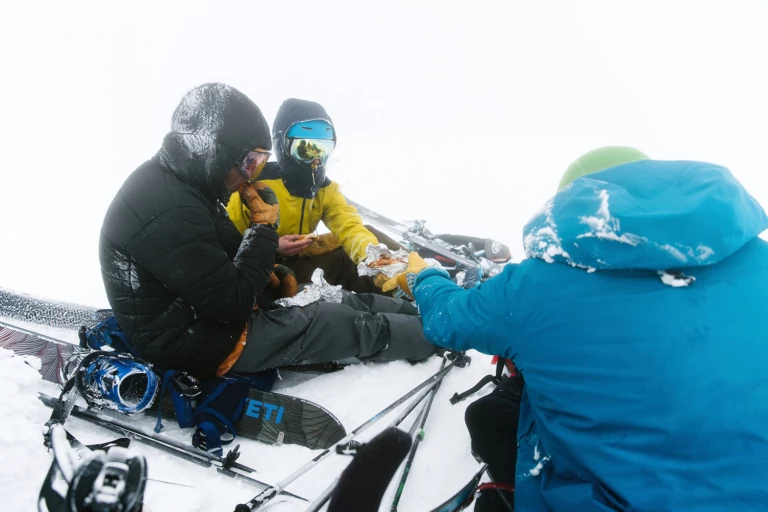
Forrest, Connor and Len braved gale-force winds, whiteout conditions and frigid temperatures for the coveted summit enchiladas prepared by Len’s mom. Photo: Greg Balkin
Increasing pressures from climate change and subsequent efforts to adapt and mitigate the impacts on public lands will likely seed many more similar conflicts. Finding a path through them may be difficult, but there is common ground that can be foregrounded to guide the way. For many tribes, the term “sacred land” refers to an area with important historical, cultural and environmental significance that must be approached according to certain protocols for management and behavior. Similarly, within the US public lands system, the designation of “wilderness” establishes etiquette that provides a similar sense of protection. Just as we would not allow the dumping of waste or the reckless development of unnecessary infrastructure in wilderness, the indigenous concept of sacredness in prescribes similar respect. However, in the face of these projected impacts the solution cannot be solved by any single stakeholder. These decision spaces require understanding the cultural viewpoints we each carry.
We descend from the cloudy ridgeline into knee-deep powder in the pine glades. I stop before dropping into a ravine to pull off my goggles and take in what is surrounding me. I am overcome by a deep wave of sadness as I think about what the future holds for the snow on this mountain, and what cultural teachings I’ll be able to impart to the next generation once it is gone. Solutions to what is ahead of us will be imperfect and incomplete, but that doesn’t mean we should not try to bridge our differences.
A visceral holler comes from the trees above me, and I turn up the slope to see Forrest carve between trees and finally emerge from a cloud of snow beside me. We high-five, and as Forrest begins heading toward the ravine below, he says, “Thanks for sharing this place with me. We gotta respect the mountains, and the elders.”
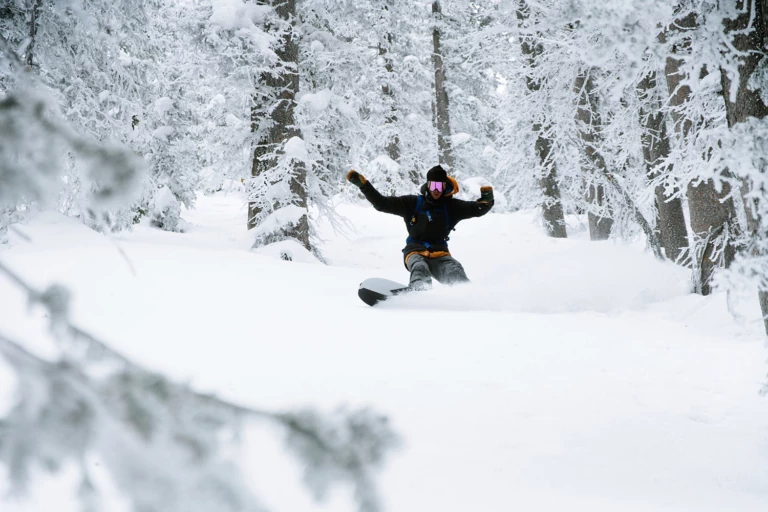
By the end of the century, climate scientists project that this mountain will no longer hold a consistent snowpack as snow will be replaced by rain. Here Forrest captures turns that may no longer be possible in the future. Photo: Greg Balkin
